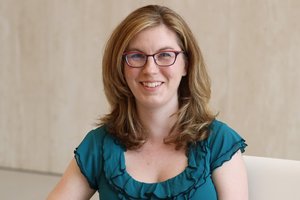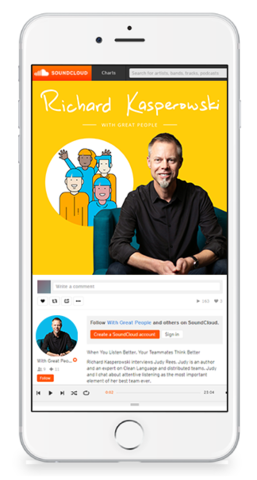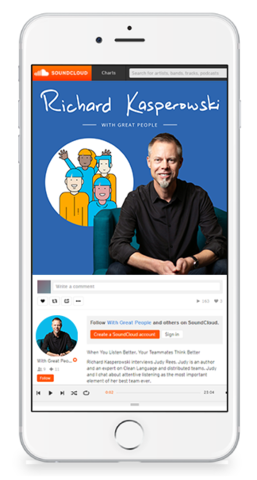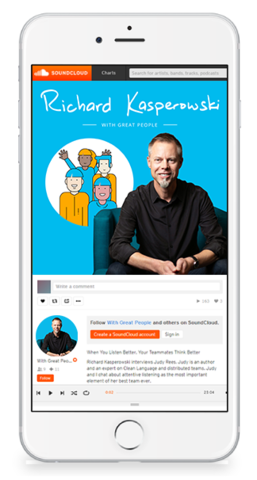Categories
Allison Pollard: How to Give a Sense of Ownership to your Team?
Richard Kasperowski interviews Allison Pollard. Allison is the director of Improving, an agile coach, creative facilitator, consultant, and public speaker. We talk about the importance of giving your team a sense of ownership. Can that be done? And how? When you finish listening to the episode, make sure to connect with Allison via LinkedIn and Twitter, and check out her blog at http://www.allisonpollard.com.
Allison Pollard: How to Give a Sense of Ownership to Your Team?
with Allison Pollard
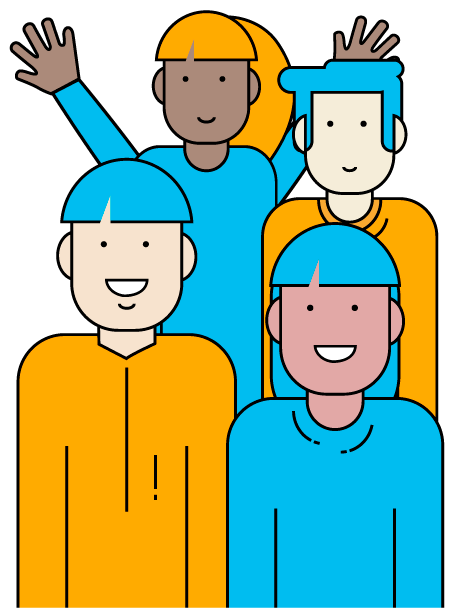
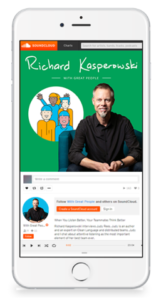
TRANSCRIPT
Richard: (00:11) Hello friends. Welcome back to With Great People, the podcast for high performance teams. I’m Richard Kasperowski. In this episode, I sit down for a chat with Allison Pollard, director at Improving, a one step IT service solution firm. Allison is an agile coach, creative facilitator, consultant and public speaker. We explore a well known management mantra that you’ve certainly heard before, “Give your team a sense of ownership over a project and their performance will skyrocket.” Easier said than done. Well today, Allison gives us a few tips that will help you crack this mystery and set you and your team on the path to success. To support this podcast, visit my website, Kasperowski.com. Our special guest today is Allison Pollard. Hi, Allison. How’s it going?
Allison: (01:07)
Hi. Good, good.
Richard: (01:09)
Could you introduce yourself to our listeners?
Allison: (01:12)
Yeah. I’m an agile coach in Dallas. I work for Improving. We’re a technology training and consulting company and we believe that trust changes everything. So our commitment is to establish trust and then help our clients with either software delivery or agile or user experience, whatever it is that they brought us in for. My personal passion is helping people discover their agile instincts and develop their coaching abilities.
Richard: (01:41)
All right. What do you mean by agile instincts?
Allison: (01:43)
You know when you’ve been following this like agile manifesto, trying to follow Scrum or Kanban or whatever framework you’re using and it starts to kind of kick in of like, “In this situation, it feels like we should do this new thing instead of doing it the old way,” that’s what I want to help people figure out, of trust your instinct. Listen to your gut, follow your intuition in learning this new way of operating.
Richard: (02:10)
All right, awesome. Awesome. This is the podcast about great teams. Before we pressed the record button and started recording this session, we were talking about what it means to have a team. I like to say a team is any group of two or more people aligned with the common goal. So it could be a work team, could be a not work team.
Allison: (02:29)
Mm-hmm (affirmative).
Richard: (02:30)
What’s the best team that you’ve ever been on in your entire life?
Allison: (02:35)
Oh gosh, good question because gave some thought to this in advance and there are certainly a lot of teams I’ve worked with in software development and teams of coaches that I’ve worked with, but the one that actually stood out for me was volunteer team. We were helping out a nonprofit organization put on a three and a half day leadership academy for college students and alumni who had studied engineering. So if you can imagine, two of us started off as organizers and doing all this planning, finding the location, trying to think about what the schedule might look like overall. Then we recruited 12 additional volunteers and trained them up as facilitators. So we are a distributed team spread out across the US and we would have monthly phone calls and then we met in person for the event itself.
Richard: (03:29)
Cool. Tell me more about this. How did you find your first teammate and growing it to 12 people? [crosstalk 00:03:36]
Allison: (03:36)
Yeah. I think my first teammate was an obvious one. I’d been involved in this nonprofit for some time and had met a lot of different alumni. This one person stuck out to me. He is an industrial engineer by trade. He is super organized, great at optimizing things. When it comes to figuring out budgets and all of that, he’s the guy. So I knew I needed someone strong in logistics because I could handle all of the content creation and really focus on training people up.
Richard: (04:10)
Mm-hmm (affirmative).
Allison: (04:11)
He and I just had this strong connection anyways where it just feels so easy to work together. He was the obvious choice.
Richard: (04:18)
All right. When you look back at that team, if you could take yourself back to the experience of working together with him or with the whole group of 12 and re-feel, feel what it felt like to be doing that activity together, preparing for that event, doing that event; could you summarize that sensation of being part of the team in one word?
Allison: (04:40)
What I’m feeling is like just enthusiasm. I actually started to feel like a little bit of like goosebumps, along my arms, like Oh God. It was so magical. Everyone was just so in, and again, this is a volunteer thing. You’re spending your weekends, times in the evening trying to put together materials, but everyone was just so committed to what we were doing.
Richard: (05:04)
I love that. I love the way you said it. I have the advantage over listeners. I can see your face when you talk-
Allison: (05:07)
Right, right.
Richard: (05:08)
… and your face totally lit up. It was enthusiasm, goosebumps. Everyone was so in.
Allison: (05:14)
Yeah. Yeah.
Richard: (05:16)
What was it about the working together? The work, the goosebumps-
Allison: (05:21)
Yeah.
Richard: (05:21)
… the enthusiasm. What about other subjective things you could use to gauge that this was a really great team? Anything objective that you can use to gauge that this was a really great team?
Allison: (05:31)
Yeah. Well, I think part of what blew me away… We had set this goal that we were redoing content for the first time in about 10 years. When you’re putting on an event for a hundred people, you really have to think through the activities and the instructions and the participation level and all. I had done a lot of pre-work, trying to figure out content areas like modules that we could have focusing around leadership skills like how do you give an effective presentation? How do you facilitate something? What are your core values as a leader and how do those show up for you? What really impressed me with this team and really took me by surprise,” the first time we started going through the materials, people were like, Oh my God, I love this.” Then they took ownership in pairs and then they started redoing it. I went, “Oh my God. Why are they redoing all this stuff?” I thought I had gotten something good enough to work with.
Allison: (06:30)
I was like, “Okay. You’re starting to change it. Maybe it’s just tweaking.” Then I was like, “Oh gosh. No, they’re making some big changes. Now, we’re talking about the activities.” Giving them that ownership, that responsibility, felt a little scary at first, but it was absolutely the best thing that could have happened because what I realized when they had partnered up, again they’re partnering up with someone they might not know all that well that probably lives in a different part of the country from them, could be a different kind of engineering background, very different job, very different skills that they bring, they started negotiating like, “What are you good at? What am I good at?” and what is it that we’re both wanting to learn? We’re volunteering, there’s some really cool opportunity here and we know it’s going to be a really safe environment for us to learn, as well as all of these students.
Allison: (07:23)
What they were doing when they created the content was trying to figure out how did they bring their own personal stories into the materials and how could they bring in activities that they had maybe seen before or experienced before, they felt really comfortable with.
Richard: (07:38)
Mm-hmm (affirmative).
Allison: (07:39)
… and it was a little chaotic to watch, especially because as you imagine, there’s clearly a deadline. There is an event where people are showing up and things need to be completed before, so we could have materials printed, what have you, but it’s that passion. People are continually changing stuff, making those edits as they think of new things and refine their ideas. I love that at least, they were keeping me in constant communication. We relied on a lot of electronic tools, Zoom calls. We had GroupMe for texts, email communication, and certainly, Google documents for all of our materials. They had voted on what the theme of the Academy should be. The group decided, “Let’s have the superhero theme,” because superhero movies were very, very popular a couple of years ago.
Richard: (08:30)
Mm-hmm (affirmative).
Allison: (08:30)
One of our volunteers created capes for every person and we had decided there’d be two days you’d wear your superhero tee shirts and then on the third day, wear a tee shirt for the organization itself.
Richard: (08:46)
Nice.
Allison: (08:46)
So there was just this great sense of fun and play that people brought into it throughout.
Richard: (08:51)
As you’re telling the story, I started to literally feel the fear in my belly.
Allison: (08:58)
Right, right. Yeah. Yeah. Again, like I said, a hundred people-
Richard: (09:02)
Yeah.
Allison: (09:02)
You’re talking about get three and a half day a bed. There’s a lot of logistics. There’s a lot of nuance into putting together how much like introspective activities do you have? You probably have a lot of introverts, it’s engineering students. Then how much full group engagement do you have? Where are they partnering up with people? It’s a lot to balance out.
Richard: (09:24)
Yeah. I totally feel that. I care a lot about learning content-
Allison: (09:29)
Yeah.
Richard: (09:29)
… creation as well. Oh my God, I don’t know if I could let other people do it for me.
Allison: (09:36)
Yeah, yeah. Well, and actually, this was the thing. So when my friend David and I recruited, like, “Who are these volunteers going to be?” We thought about folks that had obviously attended this event before, that seemed very enthusiastic as volunteers, as alumni regardless, but we also thought about, “Where are they in their life? Where are they in their learning journey and where might this be able to give them that really cool opportunity of how often does someone get to stand in front of a room of a hundred people and share their personal experience and try something kind of new and novel for them? But it’s going to be really, really safe.” Because that’s the one thing I feel like I can really bring to someone is, I’m more than comfortable in front of a group at this point in my career that I can help make it okay for you to try stuff out, possibly make some mistakes and not feel completely embarrassed by the end of it.
Richard: (10:32)
Awesome. You’ve shared a few of the concrete practices that you used with the group. What are some of the other concrete practices that went into this being such a great team?
Allison: (10:41)
Yeah. Yeah. Well,, I think back to when we first came together as a group, right? I’ve sent out all these invitations individually asking them very nicely, “I really think you could be a great part of this. Would you be willing?” I get all these yeses. We have that first group call and we’re all on Zoom, so you have all these folks kind of looking at one another on the video cameras like, “Who are they? Oh my God.” I feel kind of old in comparison.
Richard: (11:10)
You got that Brady bunch grid on the screen-
Allison: (11:12)
Yeah, right?
Richard: (11:13)
… all these boxes above them and next to them.
Allison: (11:15)
Yeah. Yeah, and it’s 12 of us. Setting aside the time, “I want each person to introduce yourself, not only your name and where you’re from and not even just what you do, but what was your connection to this organization? What is it that got you excited about being a part of this event? What’s your connection to it?” When you spend the time hearing those kinds of stories from people, like how they connect to that purpose, it’s really easy to build connections and start to trust them more because it’s not just, “Oh. Well, Allison asked me and I thought I’d be like famous for a weekend. So like I’m all in.” I think back to how I got started in my career. For me personally, the first couple times that I got to stand in front of a group and give a presentation or facilitate a larger group was through this nonprofit.
Allison: (12:13)
This is the group that gave me the skills that set me into my career. That’s a really big deal and that’s part of the reason I was wanting to give back and continue to refine the learning that we could provide people. When you hear stories like that and you’re like, “Wow. We’re doing something very important for one another,” and for these students that are going to be showing up, how can we make that? How can we honor that as much as possible?
Richard: (12:42)
Yeah. Beautiful. So the team launch, “Introduce yourself, share your connection to the group, to the mission.”
Allison: (12:48)
Yeah. Yeah. Even I think they kind of got to shape what is it that we want this experience to be like?” I might have the beginnings of a vision, but help fill it in. What do we really want this to be like? What do we want it to feel like for people? Because again, you’re talking about folks coming from all over the US and spending three and a half days together. That could be super awkward or that could be super high connection and amazing.
Richard: (13:18)
Yeah.
Allison: (13:18)
That’s what we were aiming for.
Richard: (13:20)
Beautiful. Beautiful. How about some advice for listeners? How could listeners replicate some of the success, some of the awesomeness that you felt and experienced with this team?
Allison: (13:32)
There’s that sense of like, how do you leave room for participation? I kind of picked this up from Lisa Adkins. When she had kicked off one of her classes, she kind of throws papers and markers onto the floor; very, very unstructured, I’ll say. There’s something amazing about, and we’ve kind of see this in open space as well, right? There’s just materials available in the middle. It’s very inviting for people to just come up and take what they need and use that to share their opinions or share their topics or whatever the activity is. I liked this idea of how do you leave things kind of undone or unstructured enough where it’s very easy for someone to do their own thing with it?
Richard: (14:20)
Right.
Allison: (14:21)
So having the beginnings of a vision and not a super refined division, you get people to participate in filling out the rest of the vision when it’s rough enough that they can go, “Oh, it’s not quite there.” I think it’s silly, but I’m like, man, I thought the content was pretty darn figured out, but it was clearly only about like 80% even in my head. They saw like man, there’s still a gap in what needs to get it to completion and they squeezed in more space to make bigger changes and do more with it. So letting people make stuff their own and really have that ownership, I think is a big, big deal. It was also, I think important along the way to express appreciation. This is something that I’ve seen as an agile coach as well. We talk about folks that are learning new behaviors or they’re trying something different and that could be a very scary place for them.
Richard: (15:22)
Yeah.
Allison: (15:22)
Expressing appreciation, “I see what you’re doing and I love that you’re putting in the effort to do that,” or, “Wow, you just did this new thing and that really works.” For us, it was appreciation throughout all these phone calls of like, “Thanks, everyone for showing up at 8:00 AM on a Saturday for us to have a phone call and we’re going through all these materials and thank you for that comment and I love what you’re bringing out right now.” Appreciating people first and is what seems like their job or the obvious things is actually a really big deal because that’ll keep us pumped up and feeling motivated to keep going.
Richard: (15:59)
Beautiful. So another thing about producing these podcasts is, well, I get to connect with awesome people like you.
Allison: (16:07)
Right? Kind of jealous.
Richard: (16:12)
And I always learn something new and I’m thinking express appreciation. Yeah, I can do that. I don’t do it enough. I can do that. Leaving room for participation, leaving things rough enough, undone enough, that’s definitely something for me to work on for myself, to improve in myself. A good tip for me.
Allison: (16:34)
Cool. Yeah. I think back to I had a job as a business analyst. It was my first foray into the agile world and my boss gave me this book on agile documentation and I read it cover to cover like a good employee. But the gist of it was as a business analyst, what was going to be the least amount of documentation that I could produce to help my team deliver the right software? That almost became a personal challenge of can I get it down to one page? Is it just a process flow at the whiteboard? Let’s have a lot of conversations and see what happens. I think to the agile manifesto in that sense of… We sometimes joke about the principle around simplicity and maximizing the amount of work not done.
Richard: (17:26)
Exactly.
Allison: (17:27)
You really don’t go to your boss and say, “Hi. Today, I’m going to maximize the amount of work not done.” They’re going to look at you and be like, “I’m going to optimize you out.”
Richard: (17:36)
I’m going to maximize the amount of money I don’t pay you.
Allison: (17:39)
Right, exactly. Yet, there’s something very important about how do we not put in as much effort or not do all things that we think we need to do? What is the most elegant and simple thing that could possibly work? And it might surprise us and do a lot better than we expected.
Richard: (17:59)
That’s such a good reminder.
Allison: (18:00)
Yeah.
Richard: (18:00)
Do you have anything else you’d like to add, anything you’d like to make sure listeners hear?
Allison: (18:04)
I’m sure agile-ists are going to take this as an obvious one. If you do have an event where you have volunteers,, make use of that like daily planning and end of day retro. That was something that we kind of instituted when we were there face to face. Again, it was a way for people to kind of participate and take some ownership of how things were going.
Richard: (18:24)
Mm-hmm (affirmative).
Allison: (18:26)
But for, it was huge on how can we continue to function as a team even though our schedule might’ve had us taking different responsibilities, like different breakout groups or clearly, certain people are presenting content that day and others not so much. It kept us focused and able to lean into one another on how we could make things go as smoothly as possible.
Richard: (18:48)
Yeah, I’m seeing patterns. I talked to Linda Rising-
Allison: (18:50)
Mm-hmm (affirmative).
Richard: (18:51)
… and her best team ever was a team in which, this is before agile was [crosstalk 00:18:58] they talked to each other every morning and they often talked to each other before they left for the day.
Allison: (19:05)
Yeah, yeah.
Richard: (19:06)
That’s exactly what you’re saying. Yeah. I love that I get to hear these patterns from people [crosstalk 00:19:10].
Allison: (19:11)
Right?
Richard: (19:12)[inaudible 00:19:12] each other.
Allison: (19:13)
Yeah. I remember, actually the same job where I had been at BA, my boss there had encouraged me to touch base with our tech lead a couple of times during the day and he said, “Think of it as like Dr. Pepper time. You made up 10:00 AM, 2:00 PM and maybe 4:00 PM and just kind of see how things are going and see if you need to adjust anything.”
Richard: (19:37)
All right. If listeners would like to get in touch with you, is there a way they can do that?
Allison: (19:40)
Yeah. Yeah. I am on Twitter. My handle is Allison_Pollard. I will reply to things. I admit, I am not reading Twitter all that much, I’ve been kind of busy. Or another great way to get ahold of me is to visit my blog at AllisonPollard.com.
Richard: (19:56)
All right. We’ll put links to that in the episode description, so people can just click through and find out what’s up and get in touch with you.
Allison: (19:56)
Awesome. Thank you.
Richard: (19:56)
Allison Pollard, thank you so much for joining me today. This has been a lot of fun.
Allison: (20:11)
Thanks, this is great.
Richard: (20:15)
Hi friends. Thanks for listening and remember to support this podcast. Sign up for my newsletter at Kasperowski.com.
